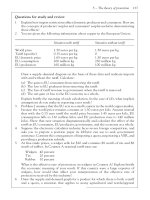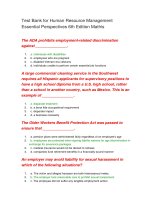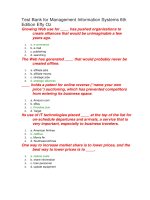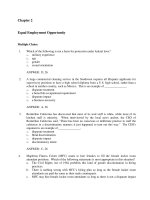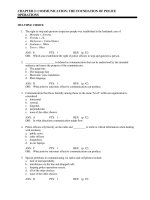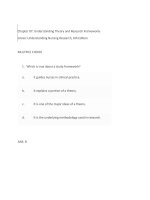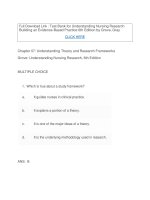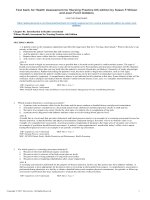Lecture Project management in practice (6th Edition) – Chapter 4: Budgeting the project
Bạn đang xem bản rút gọn của tài liệu. Xem và tải ngay bản đầy đủ của tài liệu tại đây (1.03 MB, 35 trang )
Project Management in Practice
Sixth Edition
Chapter 4
Budgeting the Project
Copyright © 2016 John Wiley & Sons, Inc.
41
Introduction
•
•
•
•
A budget must be developed in order to obtain the
needed resources
A budget is a plan for allocating organizational
resources to the project activities
A budget ties the project to the organization’s
aims and objectives through organizational policy
A budget acts as a tool for upper management to
monitor and guide the project
42
Methods of Budgeting
•
•
•
Budgeting is forecasting what resources the
project will require, what quantities of each will
be needed, when they will be needed, and how
much they will cost
Most businesses employ experienced estimators
who can forecast resource usage very well
Budgeting a project is more difficult than
budgeting more routine activities
43
Budgeting Problems
•
•
•
Project are unique activities
No history to aid estimators
Projects may be multiyear with cost escalations
–
•
Organization tradition impacts project budgeting
–
–
–
•
Changes in technology, materials, prices
How overhead and indirect costs are charged
Specific legal issues
Accounting idiosyncrasies
Project managers see costs differently than accountants
–
Accounts treat costs linearly
44
TopDown Budgeting
•
•
•
Based on collective judgments and experiences of top and
middle managers
Overall project cost estimated by estimating the costs of
major tasks
Advantages
–
–
•
Accuracy of estimating overall budget
Errors in funding small tasks need not be individually identified
Disadvantage
–
Allows budget to be controlled by people who play little role in
designing and doing the work required by the project
45
BottomUp Budgeting
•
•
•
Work breakdown structure (WBS) identifies
elemental tasks
Those responsible for executing these tasks
estimate resource requirements
Advantage
–
•
More accurate in the detailed tasks
Disadvantage
–
Risk of overlooking tasks
46
Cost Estimating
•
•
•
Details of the process of estimating costs
Some dangers of arbitrary cuts in the budget
Difference between activity budgeting and
program budgeting
47
Work Element Costing
•
Determine resource requirements and then costs for each
task
–
–
–
–
–
•
•
Fixed costs
Labor time and labor rate
Equipment time and equipment rate
Overhead
General, sales, and administrative
Full cost budget is used by accounting to estimate the
profit of the project
Project manager may also construct a budget of direct
costs
–
This provides information required to manage the project without
being confounded with costs over which he has no control
48
The Impact of Budget Cuts
•
Topdown budgets are usually lower than
bottomup budgets
1.
2.
3.
•
Job always looks easier, faster, and cheaper to the
manager
Managers are usually optimistic
Subordinates are usually pessimistic
To resolve difference…
1.
2.
3.
Subordinate explains the reality of the task
Both parties search for efficiencies
Resolving remaining difference depends on the type
of project
49
Two Project Life Cycles
Figure 41
410
Activity Versus Program
Budgeting
•
Activity oriented budgeting are based on historical
data accumulated through an activitybased
accounting system
–
–
•
Expenses assigned to basic budget lines
Lines are aggregated and reported by units
With program budgets, each project is divided by
task and time period allows for aggregation across
projects
–
–
Budget reports are shown both aggregated and
disaggregated by regular operations
Each project has its own budget
411
Typical Monthly Budget for a Real
Estate Project (Partial)
Table 43
412
Project Budget by Task and Month
Table 44
413
Improving Estimates and
Forecasts
•
•
Forms
Learning curves
414
Forms
•
A form for project resource needs might include:
–
–
–
–
•
People – managers, technical and nontechnical
Money
Materials – facilities, equipment, tools, space
Special services
And might identify:
–
–
–
–
Person to contact
When needed
How many/much needed
Whether available
415
Form for Gathering Data on Project
Resource Needs
Figure 42
416
Learning Curves
•
•
•
Humans learn when they repeat a task
It has been found that unit performance
improves by a fixed percent each time total
production doubles
Each time the output doubles, the worker
hours per unit decrease by a fixed
percentage of their previous value
–
This percentage is called the learning rate
417
Learning Curves
Tn
T1n
r
where
Tn = the time required to complete the nth unit
T1 = the time required to complete the first unit
r = log(learning rate)/log(2)
418
Other Factors Influencing the
Success of a Project
•
Changes in resource prices
–
•
•
•
•
•
Estimate rate of price change individually for
inputs that have significant impact on costs
Waste and spoilage
Team member turnover costs
Using “mythical manmonths”
Organization climate
Just bad luck
419
Budget Uncertainty and Project Risk
Management
•
•
•
Budget is an estimate made under
uncertainty
Risk pervades all elements of a project
Risk is particularly an issue with
performance, schedule, and budgets
420
Budget Uncertainty
•
•
•
Prices may escalate
Different resources may be required
Project may take more or less time
–
Impacts indirect costs
421
Estimate of Project Costs with
Uncertainty Shown
Figure 43
422
Estimates of Project Cost at t0
Figure 44 (a)
423
Estimates of Project Cost at t1
Figure 44 (b)
424
Estimates of Project Cost at t2
Figure 44 (c)
425
